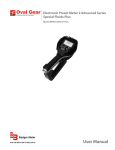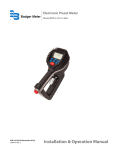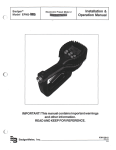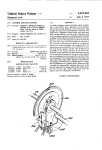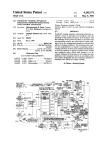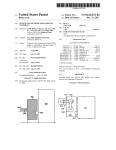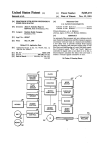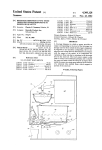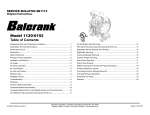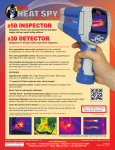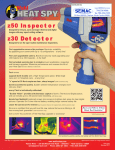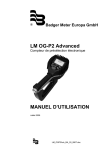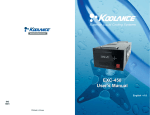Download RF ELECTRONIC PRESET METER
Transcript
SERVICE BULLETIN SB3056 Rev B 12/08 ® RF ELECTRONIC PRESET METER Model 3331-018 Thoroughly read and understand this manual before installing, operating or servicing this equipment. OPERATION, INSTALLATION, MAINTENANCE AND REPAIR GUIDE Disclaimer The user/purchaser is expected to read and understand the information provided in this manual, follow any listed Safety Precautions and Instructions and keep this manual with the equipment for future reference. The information in this manual has been carefully checked and is believed to be entirely reliable and consistent with the product described. However, no responsibility is assumed for inaccuracies, nor does Balcrank Products, Inc. assume any liability arising out of the application and use of the equipment described. Should the equipment be used in a manner not specified by Balcrank Products, Inc., the protection provided by the equipment may be impaired. Questions or Service Assistance If you have questions regarding the product or this document contact: Balcrank Products, Inc. 115 Reems Creek Rd. Weaverville, NC 28787 Telephone: (828) 645-4261 (800) 747-5300 Fax: (828) 658-0840 (800) 763-0840 On the Web: www.balcrank.com or call your local Balcrank Products, Inc. representative. Product Identification Information Record the product identification numbers from the nameplate here. Model Number _______ Serial Number _____________ Tag Number _______________(if applicable) Table of Contents DISCLAIMER.......................................................................................................Back of front cover QUESTIONS or SERVICE ASSISTANCE............................................................Back of front cover PRODUCT IDENTIFICATION INFORMATION....................................................Back of front cover Table of Contents................................................................................................................................. Explosions and Fire Hazards................................................................................... Meter Hazards............................................................................................................ FCC Compliance.................................................................................................................................. METER OVERVIEW ...........................................................................................................................1 Meter Buttons.........................................................................................................................1 LCD Display........................................................................................................................................2 METER INSTALLATION.....................................................................................................................2 Relieve System Pressure......................................................................................................2 Grounding..............................................................................................................................2 Flushing Procedure...............................................................................................................3 Apply Meter to Hose..............................................................................................................3 Apply Nozzle to Meter............................................................................................................4 METER OPERATION, RF MODE.......................................................................................................4 History Icon ...........................................................................................................................5 Error Codes............................................................................................................................6 METER OPERATION, EPM MODE....................................................................................................7 Manual Mode..........................................................................................................................7 Batch Mode............................................................................................................................7 Return to RF Mode.................................................................................................................8 OPERATING MODE FUNCTIONS .....................................................................................................9 Re-settable/Accumulated Totals...........................................................................................9 Emergency Override..............................................................................................................9 SERVICE ..........................................................................................................................................10 Low Battery .........................................................................................................................10 Changing the Battery ..........................................................................................................10 CHANGE FACTORY SETTINGS......................................................................................................11 Programming Verson 17 & Below..............................................................................11 & 12 Programming Verson 18 or higher............................................................................13 & 14 CALCULATE SCALE FACTOR .................................................................................................1 Absolute Scale Factor.........................................................................................................15 Chart of Scale Factors.........................................................................................................16 Sample Fluids, Viscosities and Scale Factors..................................................................16 Specifications..................................................................................................................................17 Parts Drawings.......................................................................................................................18 to 20 Troubleshooting .............................................................................................................................21 EXPLOSION and FIRE HAZARDS Improper grounding, poor ventilation, open flames or sparks can cause a hazardous condition and result in an explosion or fire and cause serious injury. • Be sure the fluid system is properly grounded. See your pump instruction manual for details. • If there is static sparking or if you feel an electric shock while using the meter, stop dis pensing immediately. Identify and correct the problem before continuing. • Provide fresh air ventilation. This will avoid the buildup of fumes from the fluid being dis pensed. • Do not smoke while dispensing flammable fluids. • Keep the dispensing area free of debris including solvents, rags and spilled gasoline. METER HAZARDS Equipment misuse can cause the meter to rupture or malfunction and cause serious injury. • This equipment is for professional use only. • Read all instructions, tags and labels before operating the equipment. • Use the equipment only for its intended purpose. • Do NOT modify or alter the equipment. • Do NOT leave equipment unattended while dispensing. • Check equipment daily. Repair or replace worn or damaged parts immediately. • Do NOT exceed the maximum working pressure level of the lowest rated system comp nent. • Use only extensions and nozzles that are designed for use with this equipment. • Use only fluids and solvents that are compatible with the equipment. Read all fluid and solvent manufacturer’s warnings. • Tighten all fluid connections before operating this equipment. • Do NOT stop or deflect leaks with hands, body, gloves or rags. • Do NOT dispense towards any person or any part of the body. • Do NOT place hands or fingers over the end of or into the dispense valve. • Comply with all local, state, and federal fire, electrical and safety regulations • Use of this product in a manner other than specified in this manual may result in impaired operation or damage to equipment. This meter is designed specifically to dispense petroleum products. DO NOT USE FOR WINDSHIELD WIPER FLUID, BRAKE FLUID, OR WATER BASED SOLUTIONS. FCC ID: GIF-RF KEYPAD FCC CERTIFIED, PART 15, SUB-PART C This device complies with Part 15 of the FCC Rules. Operation is subject to the following two conditions: (1) this device may not cause harmful interference, and (2) this device must accept any interference received, including interference that may cause undesired operation. METER OVERVIEW The Electronic Preset Meter RF2 (EPM RF2) is equipped with RF (radio frequency) communications to communicate with a fluid management system keypad to get authorization and dispense information. This is referred to in the manual as the RF Mode. The meter can also be run as a standard EPM. This is referred to in the manual as the EPM Mode. This is intended for start-up purposes or when the fluid management system is not in use. Once a work order has been entered at the keypad, the operator simply pushes the button on the meter to start communications between the meter and the keypad. The meter receives authorization from the keypad to unlock and the dispense batch quantity. When the trigger is pulled the pre-set dispense batch quantity dispenses. The meter automatically shuts off when the dispense batch quantity has been reached. A “Top Off” feature allows additional fluid to be dispensed and tracked after the batch quantity has been dispensed. Upon completion of the dispense, the operator presses the button. The meter then locks, prohibiting any unauthorized dispense of fluid and the dispense quantity is sent to the keypad. Meter Buttons Used to enter the dispense Batch quantity when in the EPM Mode. These buttons are NOT used in RF Mode. Total Used to display the accumulated total of fluid dispensed, as well as the re-settable total. Meter Display Auto Used to enter and exit the manual or batch mode when in EPM mode. This button is NOT used in RF mode. Reset • • • Used to initiate RF communications from the meter to the Keypad. Used in EPM mode to clear the previous batch. Used to reset the re-settable total dispensed while pressing the TOTAL button. Shut-Off or Stop Used to stop the flow through an Emergency Override. 1 LCD Display 2 1 3 7 6 5 4 LCD Display 1. Displays re-settable total, accumulated total and Scale Factor 2. Displays Unit of Measure 3. Arrows flash when RF communication is in progress with the keypad 4. Preset Batch quantity 5. History Icon 6. AUTO is an indicator of being in EPM mode 7. Low Battery Icon METER INSTALLATION Relieve System Pressure Pressurized Equipment 1. Turn off the power supply to the pump or close the shutoff valve. 2. Dispense any fluid in the system into a waste container by opening the meter(s). 3. Open all bleed-type master air valves and fluid meter(s) in the system. 4. Leave the meter(s) open until ready to pressurize the system. This equipment stays pressurized until the pressure is manually relieved. To reduce the risk of injury from fluid spray from the meter follow the Pressure Relief Procedures when you: • Are instructed to relieve pressure • Stop dispensing • Check, clean, or service any system equipment • Clean or install nozzles Grounding 1. Grounding reduces the risk of static sparking. Ground all system components according to local, state, and federal codes. Consult the pump user’s manual and other system components to ground the following: 2. Pump: follow manufacturer’s recommendations 3. Air and Fluid Hoses: use only grounded hoses 4. Air Compressor: follow manufacturers recommendations 5. Fluid Supply Container: follow the local code Explosion and Fire Movement of fluids through the dispensing system creates static electricity. Static electricity can cause volatile fumes resulting in an explosion and fire. The dispensing system must be grounded. 2 Flushing Procedure If this installation is new or if the fluid in the lines is contaminated, flush the system before installing the meter(s). NOTE: If the system has multiple dispense positions, begin at the position farthest from the pump and move towards the pump. 1. Close fluid dispense valves at every position. 2. Once the main fluid outlet valve at the pump is closed, the air pressure to the pump motor is properly adjusted and the air valve is opened. 3. Slowly open the main fluid valve. 4. Place the hose end in a waste container. Make sure hose is secure so no fluid leaks during flushing. 5. Slowly open the dispense valve and allow enough fluid to pass through it to ensure that the system is clean. 6. Close the valve and repeat for all dispense positions. Apply Meter to Hose Close the drain valve before starting this procedure. 1. Attach a swivel to the meter. Apply thread sealant to the male end of hose. Recommended sealant is Loctite® 243. 2. Insert the metal end of the hose into the swivel. Tighten completely with an open ended, adjustable, wrench. NOTE: The threaded end of the meter always has female threads. The metal end of the hose must have male threads. Apply thread sealant, Loctite® 243, or equivalent, to the male end. The inlet and outlet swivel connections are either 1/2” NPT or 1/2” BSPP, depending on meter model. Attach the hose 3 Apply Nozzle to Meter 1. On the opposite end, apply sealant to the end of the nozzle. Recommended sealant is Loctite® 243. 2. Thread the nozzle onto the meter. Screw it in firmly with an open ended, adjust able, wrench (see caution below). CAUTION Do Not Over Tighten nozzle to handle. This may result in cracking the handle housing. 3. Open all dispense position shut-off valves. Start the pump to pressurize the system. 4. Before use, to ensure accuracy, purge all air from the fluid lines and dispense valve(s). Attach the Nozzle METER OPERATION, RF MODE When the battery pack is attached to the meter, it automatically enters the RF Mode. The trigger is in the locked-out position. No fluid can be dispensed by the meter until a dispense order is received from the keypad. Arrows Batch Quantity 4 1. Pressing the meter button causes communication to occur between the meter and the keypad. • Two (2) arrows in the lower right hand corner of the meter screen flash. This indicates communication is in progress between the meter and keypad. 2. When the communication is complete the trigger unlocks and the batch quantity is displayed 3. Pull the trigger to the full, up, position to begin the fluid flow. Release trigger once fluid flow begins. • The solenoid valve automatically locks the dispensing valve in the full open position. The trigger falls back to the closed position. • It is not necessary to continue to hold the trigger. • After the batch quantity is dispensed, the flow automatically shuts off. 4. The user has the option to top off the tank after the batch quantity has been dispensed. • To top off, pull the trigger to begin the flow. • Release the trigger when the desired amount has been dispensed. Do NOT press topping off. button before If button is pressed, the meter returns to a locked-out position and does not allow additional fluid to be dispensed until a valid dispense order is received from the RF System. 5. Press the button when finished to complete the dispense order. • The total quantity dispensed is transmitted to the RF system. • The meter returns to the locked position. • The meter is now ready to receive another dispense order from the RF system. NOTE: If the original communication fails, the meter automatically attempts to communicate with the RF system by resending the Dispense Result three (3) times, 30 seconds apart. 6. If the meter is unable to communicate a dispense result, the History icon lights. History Icon The History icon indicates there is dispense result information that has not been communicated to the keypad to complete a work order. To send the dispense result information to the keypad, press button to initiate communication. History Icon 5 Error Codes The meter has several Error Codes that may be displayed. These provide indication, at the meter, that there is an error in communication between the meter and keypad. F01 The meter has received an invalid response from the keypad. • To clear the error, press the Reset button on the meter. • Press the Reset button a second time to retry communications with the keypad. F02 The meter has not received a response from the keypad during communications. • To clear the error code, press the Reset button on the meter. • To retry communications with the keypad, press the Reset button a second time. • There may be an obstruction blocking the RF signal between the meter and keypad. It may be necessary to change your physical location. F04 There is a damaged cable assembly within the meter. • This meter should be taken out of service. • This meter may be used reliably in EPM Mode. • RF Mode will exhibit erratic behavior. SF0 (Scale Factor 0) The Scale Factor setting for the meter is set to 0.000. • To input a valid Scale Factor for the meter follow the instructions in the Change Factory Settings section of this manual. All other Error Codes are for factory purposes only. • To clear the meter, press Reset. 6 METER OPERATION, EPM MODE The meter can be put in EPM Mode for start up purposes. Refer to the Supervisor’s Instruction Manual for key sequence. The AUTO icon displays, indicating the meter is in the EPM Mode. The solenoid valve unlocks and the meter can now be used as a Standard Preset Batch Meter. NOTE: The keypad AUTO button is used to toggle between Manual Mode and Batch Mode. Manual Mode 1. Pull the trigger to begin the flow. 2. The display shows the amount dispensed. 3. When the desired amount has been dispensed, release the trigger to stop the flow. 4. Press button once to reset the counter display to zero. EPM Manual Mode Batch Mode To enter the Batch Mode from the Manual Mode press the meter button. The screen on the left appears. When in the Batch Mode, the batch quantity displays in the lower, right hand corner of the screen. EPM Batch Mode The meter is now in Batch Mode. 1. Change the batch size by pressing the , and/or buttons. a) Press the 10 button to increase the batch amount in increments of 10 units. b) Press the 1 button to increase the batch amount in increments of 1 unit. c) Press the 0.1 button to increase the batch amount in increments of 0.1 units. 7 Batch Size 2. Pull the trigger to begin the flow. • The meter solenoid valve automatically locks the dispensing valve in the full open position. The trigger falls back to the closed position. The meter always locks in the maximum open position. • After the batch quantity is dispensed, the flow automatically shuts off. NOTE: For RF and BATCH programming, the meter automatically shuts off if the trigger is pulled and the meter does not sense any flow. Also, in case of an emergency or to interrupt a batch, the meter is equipped with an Emergency Override. (See the Emergency Override section of this manual.) 3. The user has the option to top off the fluid at the end of a batch. • To top off the fluid, pull the trigger to begin the flow and release it when the desired amount has been pumped. 4. Press the button when finished. The display resets and the meter is now ready for the next batch to be dispensed. Return to RF Mode To return to the RF Mode from the EPM Mode: 1. Press button twice. You’ll see the flashing arrows indicating the meter is Arrows communicating with the RF System. 2. When communication is complete, the meter returns to the RF Mode and the trig ger locks. 8 OPERATING MODE FUNCTIONS These functions operate the same in RF Mode and EPM Mode. Re-settable/Accumulated Totals The meter has two flow totalizers. One is Re-settable Total the other is Accumulated Total. 1. To see the Accumulated Total and the Re-settable Total: • Press and hold the button to see the Accumulated Total. • Continue holding the button. • After three seconds the screen changes to the Re-settable Total. 2. Resettotal displays the total fluid dispensed since the Resettable Total was last set back to zero. 3. Press the button while viewing Resettotal to set it back to zero. Re-settable Total 4. Release the display. button to return to the operating NOTE: The Accumulated Total cannot be reset unless the user changes from English units to metric units or from metric to English units. (See the Change Factory Settings, Change Unit of Measure section of this manual). Emergency Override In case of an emergency or to interrupt a batch, the meter is equipped with an Emergency Override. 1. Press the red button to activate the Emergency Override. The override closes the valve, immediately stopping fluid flow. 2. Batching can continue after an Emergency Override by pulling up on the trigger. 9 SERVICE Low Battery When the batteries need changing a progression of warnings appears on the meter screen. First Warning: the Low Battery icon appears in the lower left corner of the display. That means the batteries are low and need to be changed when the icon appears. Second Warning: Battery icon flashes. The battery power is too low and meter functions are disabled. Low Battery Icon Changing the Batteries The battery compartment is located in the lower case on the underside of the trigger guard. 1. Turn the unit over. 2. Unscrew the two screws. Remove the battery door to expose the batteries. 3. Replace the old batteries. The meter takes 4 AA, alkaline, batteries. NOTE: Battery polarity markings are inside battery compartment. 4. Dispose of used batteries properly, according to local regulations. NOTE: Changing the batteries does not affect any of the programmed values or totals. 10 CHANGE FACTORY SETTINGS Each meter is calibrated at the factory for use with motor oil (see the Change Scale Factor section of this manual). The Unit of Measure is also selected prior to shipment. Verify Firmware Version 1. The firmware version and code checksum can be displayed by holding the and button at the same time. 2. The last two digits on the lower right are the firmware version. 3. Meters with version 17 and below use the procedure outlined in Programming Version 17 & below in this manual for changing of unit of measure, scale factor and enabling or disabling the EPM functionality. 4. Meters with version 18 or higher use the procedure outlined in Programming Version 18 or higher in this manual for changing of unit of measure, scale factor and enabling or disabling the EPM functionality. Programming Version 17 & below To change the factory settings: 1. Press the button to wake up the meter if the display is blank. 2. To enter the Programming mode turn Use a 5/32” Allen the unit over. Press and hold down the wrench or similar “PROGRAMMING” key located in the blunt tool. access hole for 2 seconds (see picture on left). 3. After the display flashes, the Unit of Measurement and Scale Factor are displayed. 4. The current Unit of Measurement will be flashing when the programming mode has been entered. Location of access hole for PROGRAMMING Key Change Unit of Measure The meter comes with an option to choose 4 different Units of Measure. Scale Factor Digits 1. The actual Unit of Measure is flashing when the Programming Mode is entered. 2. Press the button to toggle between the four options; PT, QT, GAL, L. 3. When the desired unit of measure is Unit of Measurement Programming Display 11 displayed, press the button. The Unit of Measure icon stops flashing. 4. If L, (Liters), is selected, the decimal point begins to flash. • You now have the option to change the decimal point to either a period or a comma. • To do this, press the button. 5. If no Scale Factor changes are necessary, refer to the Save Changes section of this manual. Changing the Unit of Measurement from metric to English or from English to metric clears the Re-settable Total and Accumulated Total. Change Scale Factor Changing the Scale Factor changes the accuracy of the meter, potentially causing it to overfill or under fill. This has the potential to cause a mechanical breakdown. Scale Factor Digits 1. Press the button to advance through the Scale Factor digits. 2. Press the number. Scale Factor Display button to change the selected NOTE: All digits can be scrolled between 0 and 9 except the first. It can only be scrolled from 0 to 1 or from 1 to 0. 3. Press the button to advance to the next number in Scale Factor. 4. Repeat steps 2 and 3 for all five digits in Scale Factor. Save Changes When you are finished programming these options, turn the unit over and press the PROGRAMMING key. 1. Hold the PROGRAMMING key until the display flashes three times and goes blank. 2. Press the button to turn the meter display on. Verify Changes 1. Verify Unit of Measure is correct. 2. Push and hold the button and is correct. button together, to verify that the Scale Factor 12 Programming Version 18 or higher To change the factory settings: 1. Push and hold at the same time 2. PrG will appear on the display. 3. Release the and the and buttons. buttons. 4. Then press and release in order the , , , and the buttons 5. The current unit of measure will now be flashing indicating that you have entered the programming mode. Change Unit of Measure The meter comes with an option to choose 4 different Units of Measure. Scale Factor Digits 1. The actual Unit of Measure is flashing when the Programming Mode is entered. Unit of Measurement Programming Display 2. Press the button to toggle between the four options; PT, QT, GAL, L. 3. When the desired unit of measure is displayed, press the stops flashing. button. The Unit of Measure icon 4. If L, (Liters), is selected, the decimal point begins to flash. • You now have the option to change the decimal point to either a period or a comma. • To do this, press the button. 5. If no Scale Factor changes are necessary, refer to the Save Changes section of this manual. Changing the Unit of Measurement from metric to English or from English to metric clears the Re-settable Total and Accumulated Total. 13 Change Scale Factor Changing the Scale Factor changes the accuracy of the meter, potentially causing it to overfill or under fill. This has the potential to cause a mechanical breakdown. Scale Factor Digits 1. Press the button to advance through the Scale Factor digits. 2. Press the number. button to change the selected NOTE: All digits can be scrolled between 0 and 9 except the first. It can only be scrolled from 0 to 1 or from 1 to 0. Scale Factor Display 3. Press the button to advance to the next number in Scale Factor. 4. Repeat steps 2 and 3 for all five digits in Scale Factor. 5. If no other changes are necessary, refer to the Save Changes section in the manual. EPM (MANUAL) Mode enable/disable To disable or enable the EPM mode of the meter: 1. Press the button to advance to the AUTO icon on the display, there will be no other icons flashing on the display. 2. Then press the button to toggle on and off the AUTO icon. When the icon is turned on the meter can be put in EPM mode through the special key sequence on the meter keypad. When the AUTO icon is turned off the key sequence is disabled and the meter cannot be put in EPM mode. Save Changes To Save Changes and exit the programming mode: 1. Push and hold at the same time the and buttons. 2. The display will flash 3 times and go blank. 3. Press the button and the display will turn back on. Verify Changes 1. Verify Unit of Measure is correct. 2. Push and hold the Factor is correct. button and button together, to verify that the Scale 14 CALCULATE SCALE FACTOR A Scale Factor is a number used to adjust meter accuracy. The Scale Factor is set at the factory using motor oil with a viscosity of 10W. The primary use for Scale Factor recalibration is to batch fluids with different viscosities. If the fluid has a lower viscosity, more fluid can slip past the meter gears without being detected. Changing the Scale Factor adjusts the meter to compensate for the loss. The meter multiplies each pulse by the Scale Factor number to correct the accuracy when it converts to the specified units. The reading is then always correct. For an approximate Scale Factor for fluids of different viscosities, consult the charts on the next page. NOTE: The meter’s original Scale Factor was written on the trigger when it was calibrated at the factory. It may have been revised after field installation. Use the Scale Factor showing on the display, not on the trigger. Changing the Scale Factor changes the accuracy of the meter, potentially causing it to overfill or under fill. This has the potential to cause a mechanical breakdown. To view the current Scale Factor: 1. Press and hold the button and the button at the same time. Absolute Scale Factor For absolute Scale Factor, perform this test: 1. Run a measured amount of fluid through the meter. 2. If the meter delivers 4.20 quarts and the display shows only 4.00 quarts, then the Scale Factor needs to be adjusted. 3. Divide what the meter delivered (4.20) by what the display shows (4.00). You get an error factor of (1.05). 4. The existing Scale Factor is 1.0123, as shown in steps 1 and 2 in “To view the current Scale Factor”, above. 5. To calculate a new factor: 1.0123 (existing Scale Factor) x 1.05 (error factor) = 1.0629 (new Scale Factor). 6. Enter that number as described in the Change Scale Factor section of this manual. NOTE: Use the Scale Factor showing on the display, not on the trigger. 15 Chart of approximate Scale Factors for fluids of different viscosities Scale Factor Scale Factor Viscosity in Centistokes @ 65o Samples of Fluids, Viscosities and Scale Factors 1 2 3 4 5 6 7 Fluid Water/Anti-Freeze Anti-Freeze Brake Fluid ATF 10W 80W-90 140W 16 Viscosity 5 18 42 80 140 450 1800 Scale Factor 1.044 1.007 1.004 1.002 1.000 0.999 0.993 Specifications English Metric Maximum Flow* 10 gpm 38 lpm Minimum Flow* 0.25 gpm 1 lpm Operating Pressure (Maximum) 1000 psi 67 bar Operating Pressure (Minimum) 5 psi .35 bar o Operating Temperature (Maximum) 120 F 50o C Operating Temperature (Minimum) 20o F -5o C Accuracy - Oils +/- 0.5% +/- 0.5% Accuracy - Anti-Freeze +/- 1.5% +/- 1.5% 5-Digit LCD Display, 10 mm High x Quarts, Pints, Gallons Liters 5 mm wide Inlet and Outlet Connections 1/2” NPT 1/2” BSPP * Tested with DTE-25 motor oil at ambient temperature. Min.-Max. flow range will vary with fluid viscosity. 17 ITEM# 1 2 PART DESCRIPTION Battery Holder Assembly Bottom Case with Screws 18 PART NUMBER 64103-026 64103-021 1 2 3 ITEM# 1 2 3 Not Shown PART DESCRIPTION Rubber Boot Display Assembly RF Register Assembly Swivel, NPT 19 PART NUMBER 65546-001 64103-023 64103-022 64082-001 2 1 3 ITEM# 1 2 3 PART DESCRIPTION Valve Assembly Gear Service Kit with O-ring Trigger Assembly 20 PART NUMBER 64103-001 62896-001 64103-015 TROUBLESHOOTING Relieve the pressure prior to checking or repairing the meter. Make sure all valves, controls and pumps are operating correctly. Symptom Battery Icon is displayed Display Blank Meter does not latch for batching Slow or no fluid flow Meter inaccurate Batch overruns program value Possible Cause Batteries are low Meter asleep Remedy Replace batteries Push reset button Loose battery connection Remove battery pack and check battery connection/ Push reset button Batteries Dead Replace batteries/Push reset button Press AUTO button and program batch size Meter not in AUTO mode Meter not reset after prior batch Press RESET button Low batteries Check for battery icon/ replace batteries/push RESET button Clean or replace the filter in the swivel nut Filter is clogged Pump pressure is low Turn up the pump pressure Foreign material is jamming meter Scale factor not correct for fluid Contact your local distributor for repair Enter program mode, check and reset program factor Enter program mode, reset pulse delay to higher value Pulse delay value set too low 21 Balcrank Lubrication Equipment Warranty Statement All Balcrank equipment sold by authorized Balcrank distributors is warranted to their original customer to be free from defects in materials and workmanship for a period of one year from the date of sale to that customer. Selected Balcrank equipment carries warranty terms for a more extended period as defined in the Balcrank Lubrication Equipment & Accessories User Price List, wherein a “lifetime” warranty represents a warranty period of thirty years. Within the initial one-year warranty period, Balcrank will repair or replace all Balcrank equipment determined by Balcrank to have defective materials or workmanship. For equipment carrying more extended warranties, Balcrank will repair or replace the product including parts and labor during the first full year and will provide parts only for the remainder of the warranty period. This warranty applies only to equipment installed and operated according to applicable Balcrank Service Bulletins and Installation Instructions. Any equipment claimed to be defective must be returned, freight prepaid, to an Authorized Balcrank Service Center (ASC). Upon receiving candidate warranty equipment from a customer, ASC will: 1) diagnose to determine the warrantable condition of the equipment, 2) submit, prior to repair or replacement, a request to Balcrank for warranty authorization, then 3) in cooperation with Balcrank, proceed with repair locally or forward the equipment to Balcrank and obtain replacement. If the part(s) or equipment items are found defective upon inspection by Balcrank, they will be repaired or replaced, and then will be returned to the ASC. If Balcrank finds the claimed part(s) or equipment not to be defective, the ASC will receive written authorization from the original customer, and then repair them for a reasonable charge to the customer, which will include all applicable parts, labor, and return transportation costs. Optionally, the customer may submit certain eligible products directly to Balcrank for warranty return by using Balcrank Lubrication Equipment Direct Service Warranty Procedure. Eligible products are defined in the Balcrank Lubrication Equipment & Accessories User Price List. Refer to the Balcrank web site www. balcrank.com for a copy. Any equipment returned to Balcrank must have the Warranty Service Claim number (WSC#) clearly marked on the outside of the carton. Balcrank’s sole responsibility is for defects in material and workmanship, and Buyer’s sole and exclusive remedy hereunder, shall be limited to repair or replacement of the defective part or equipment. This warranty does not cover, nor shall Balcrank be liable for repair or replacement of parts or equipment resulting from general wear and tear through use, or damage or failure caused by improper installation, abuse, misapplication, abrasion, corrosion, insufficient or improper maintenance, negligence, accident, alteration, or substitution of non-Balcrank parts. Furthermore, the Warranty for Lubrication Equipment and Accessories does not cover the following specific conditions: • • • • • • • • Failure or damage to equipment caused by dirt or debris in compressed air lines and fluid lines. This includes, but is not limited to, clogged inlet filters, strainers, or regulators; fluid meters; control handles; fluid tips; and valves. Failure of normal wear parts including but not limited to: o-rings, packings, seals and valves unless originally improperly installed by the factory. Products placed in applications for which their use was not intended. Examples include but are not limited to Lubricant pump being used to pump solvents, or placing equipment intended strictly for indoor use outdoors Damage to equipment resulting from operation above and beyond Balcrank’s recommendations. Leaks at air and fluid fittings and connections. Damage caused by thermal expansion whenever adequate pressure relief was not included in the system. Loose suction tubes on pumps. Incorrect hose reel spring tension, requiring adjustment. THERE ARE NO OTHER WARRANTIES, EXPRESSED OR IMPLIED, INCLUDING WARRANTIES OF MERCHANTABILITY OR FITNESS FOR A PARTICULAR PURPOSE. IN NO EVENT SHALL BALCRANK BE LIABLE FOR ANY SPECIAL, CONSEQUENTIAL, OR OTHER DAMAGES OF SIMILAR NATURE, INCLUDING BUT NOT LIMITED TO LOST PROFITS, LOST PRODUCTION, PROPERTY DAMAGE, PERSONAL INJURY, WHETHER SUFFERED BY BUYER OR ANY THIRD PARTY, IRRESPECTIVE OF WHETHER CLAIMS OR ACTIONS, LEGAL OR EQUITABLE, FOR SUCH DAMAGES ARE BASED UPON CONTRACTS, WARRANTY, NEGLIGENCE, STRICT LIABILITY, OR OTHERWISE. ANY CLAIM OR ACTION FOR BREACH OF WARRANTY MUST BE BROUGHT WITHIN TWO (2) YEARS FROM THE DATE OF SALE TO THE ORIGINAL CUSTOMER. Balcrank® Products, Inc. 115 Reems Creek Road Weaverville, NC 28787 800-747-5300 800-763-0840 Fax www.balcrank.com SERVICE BULLETIN SB3056 Rev B 12/08 832435 Distributed by: Revision Log: New Release - 12/07 Rev. A - 8/08 - Added programming instructions for version 18 and Updated Warranty Statement Rev. B - 12/08 - Added caution about tightening nozzle on page 4


























